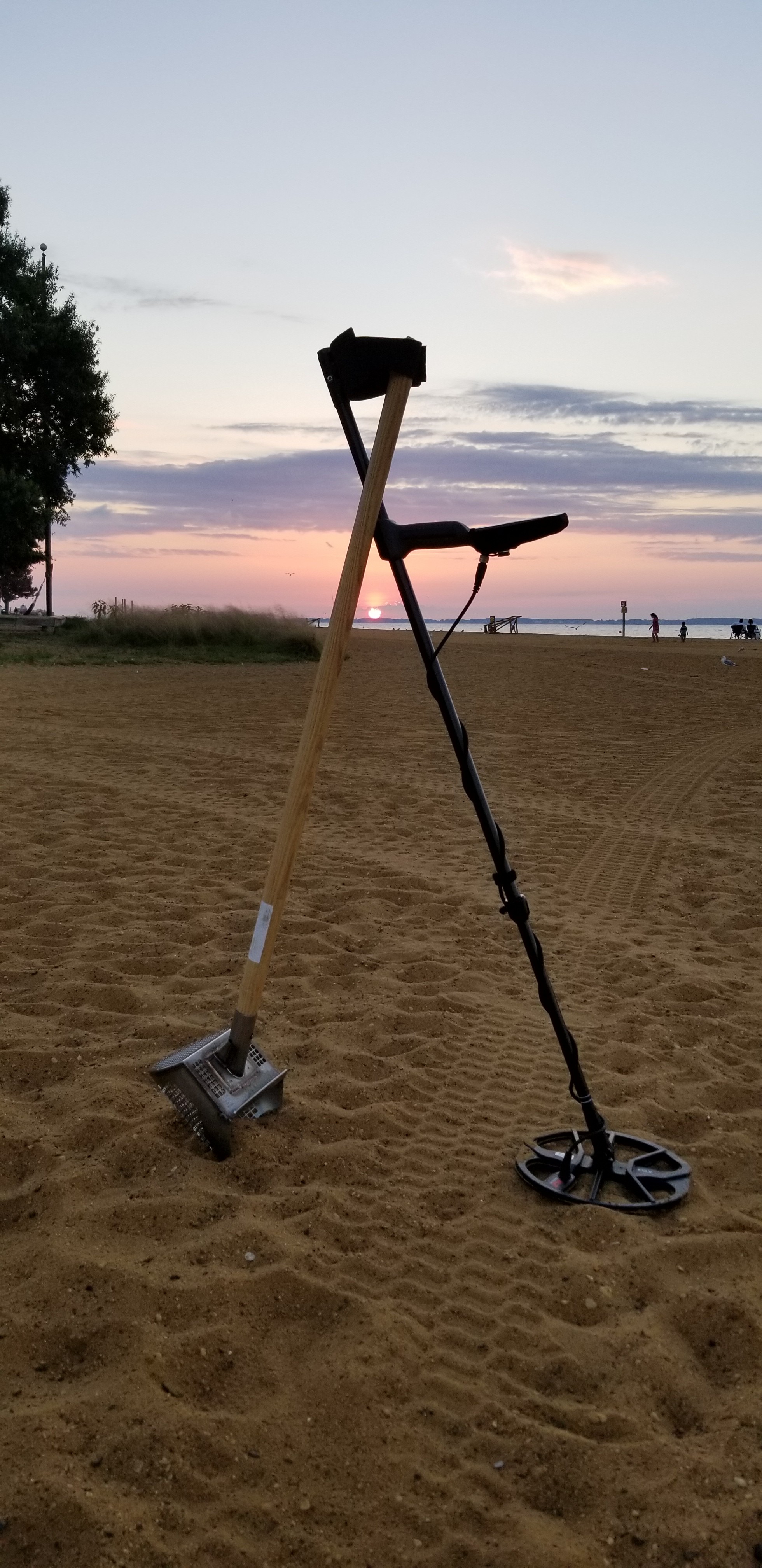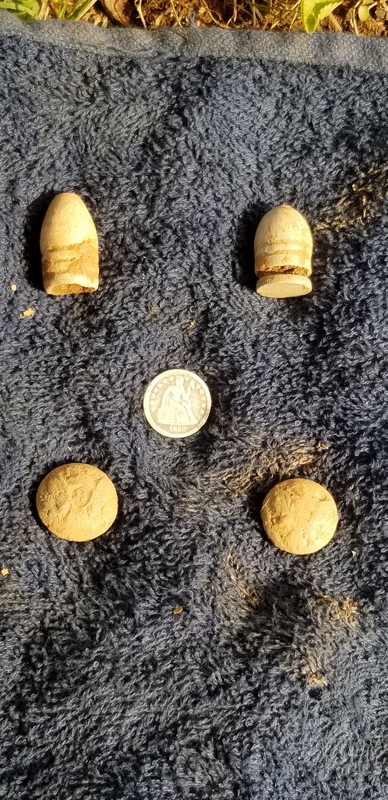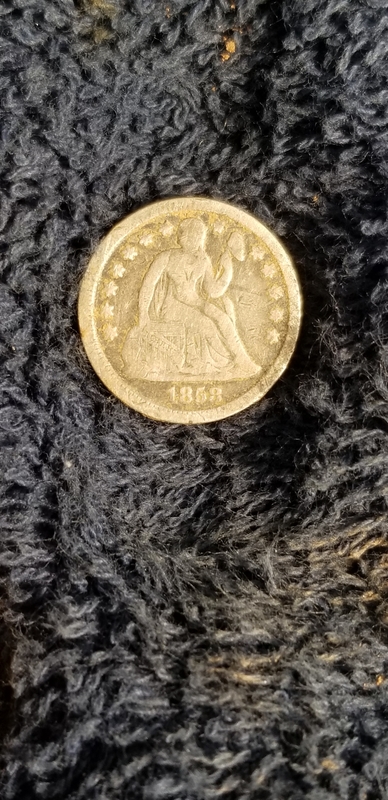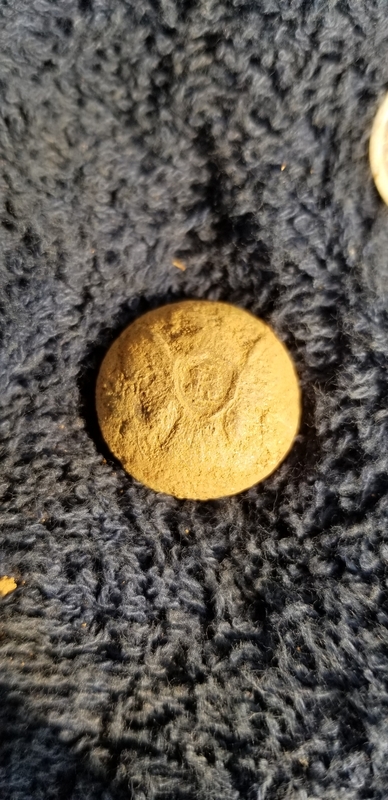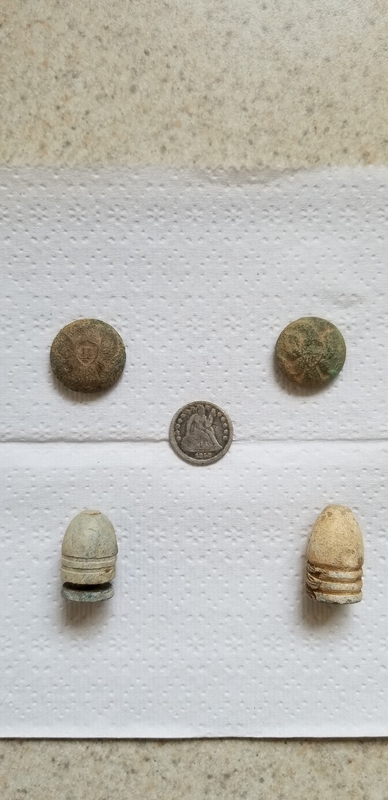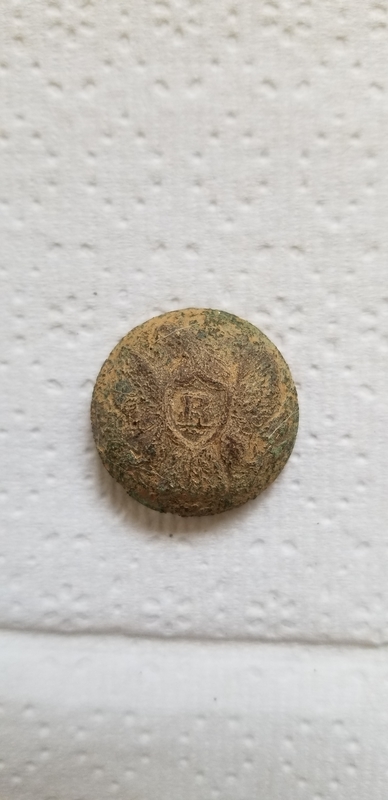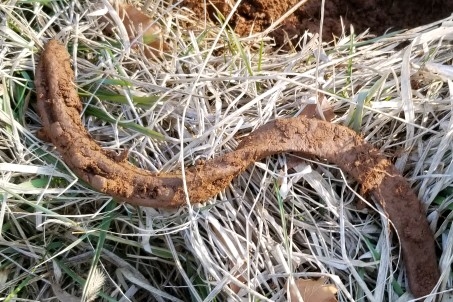-
Posts
6,130 -
Joined
-
Last visited
Content Type
Forums
Detector Prospector Home
Detector Database
Downloads
Everything posted by Chase Goldman
-
I am loving my Equinox 800 relic machine (soon to be my Equinox beach machine and my Equinox water machine and also my Equinox park and gold machine). Hit the PA site I lovingly refer to as the relic hunter's amusement park which has been the site at which I have obtained several firsts and bucket listers including my first CW plate of any kind which I posted a few weeks ago. I have hunted it the last few times with the Equinox and it sets up well for that machine. For relic hunting, I generally favor Field 2 at the default settings. I have been experimenting also with Park 2. While the default settings for both are similar, there is definitely a difference in the underlying Multi IQ secret sauce based on the way the targets sound and also the way they hit the targets. I found Park 2 to hit a little bit harder on higher conductors, but this could just be my imagination. In this field, I like the Field 2 disc breakpoint at 2 because hot "rocks" in this field (from steam tractor coke tailings) come in at 1 consistently, and the Field 2 breakpoint is 2 vice 9 for Park 2. This is somewhat of a moot point because I generally run All Metal, but occasionally cut in disc when my brain needs a break and just listen for high tones. But the jury is still out as far as I'm concerned as to which of those modes I prefer most for relic hunting. I set up the machine to have the "main" program be Park 2, but with some Iron Bias cut in (3). I have Field 2 loaded up in the User Profile slot without modification from the defaults. In this manner I have a setup where I can quickly interrogate a target with or without iron bias with just a press of the User Profile button. Works great. I also cut in GB tracking for both modes in this hunt. The field has mild mineralizaation and Ground Phase variations typically seen in a plowed field with different crops and it worked well. Well, Equinox delivered once again. Scored a beautiful 1858 Seated Dime (she turns 160 this year, no wonder she is sitting down) and my first Rifleman's Eagle Button ("Eagle R"). Rounded out the hunt with a minie ball, a Williams Type III "cleaner" minie ball (my first Type III), and another Eagle button. Not shown are a 1936 Wheatie and various tiny non-ferrous odds and ends including lead, brass, and copper fragments. Pulled some large ferrous objects too as I had the time to chase some iffy signals and did so. Large, flat iron rings high and forces me to investigate, but in all metal, you can hear the iron grunt too and know you are likely digging some iron and not a masked keeper. But if you have the time...dig 'em because you never know... The site really helps, I have had success here with the Deus as well, but no doubt the Equinox can, will, and has delivered the goods and I gain more confidence with it in every successive outing. HH
-

What To Expect Go Find 40 -> Equinox 800
Chase Goldman replied to nwprospector's topic in Minelab Equinox Forum
A pinpointing exercise I learned involved taping coins to irregularly sized flat pieces of cardboard. Flip the cardboard onto the ground (coin side down) then attempt to PP the coins. You can even go so far as poking holes through the cardboard with a pen or golf tee at the point where you think the coin might be to see how close you are. Great way to practice and compare different pinpointing techniques without the underlying bias that results from seeing the object you are pinpointing while you are pinpointing it. Not sure, but I think the coils on the Go Find series detectors are square coaxial, which is inherently easier to pinpoint with than a DD coil since the target pinpoints in the center of the coil vs. along the vertical center spine of a DD coil which represents the active region of the DD coil. Can't explain the degradation in your pinpointing techniques but suggest the above exercise to get your PP mojo back. -

Help Needed After First Trip Out
Chase Goldman replied to Walter S. Fowler's topic in Minelab Equinox Forum
Walter - tracking seems to work well when there is enough mineralization present in the soil for the tracking algorithm to latch onto (even though you cannot determine the level of ground mineralization just by noting a ground phase reading, changes in mineralization will change ground phase and thats what makes the tracking algorithm work). As long as your ground is not super hot causing wild swings in ground phase, I don't think tracking is needed. Problem with the Equinox, even though it can apparently sense ground mineralization, it does not have a mineralization meter or bargraph to tell you how mineralized the ground is. Periodic auto balancing ground phase by pumping is typically all that is needed for most situations since the Equinox is very forgiving to a less than optimal ground balance. -

Zeroed It Down To The Right Area. First Nox Silver!
Chase Goldman replied to SittingElf's topic in Minelab Equinox Forum
Congrats on the silver and the other keepers. Some cool odds and ends. Way to do the research to make it pay off. -

Help Needed After First Trip Out
Chase Goldman replied to Walter S. Fowler's topic in Minelab Equinox Forum
Walter - First of all, hang in there. It is going to be a frustrating journey because you are being forced out of your 14-year XLT comfort zone. It is not going to be love at first sight. You apparently picked a tough site situation and without experience on the machine did not have enough familiarity with the machine to be able to tweak it to compensate for a tough situation (sprinkler pipe and few targets). The XLT and the Equinox are very different in their speed and range of target sensitivity so you can easily get overloaded by what the Equinox is telling you. I was coming from a Deus which is similar to Equinox in terms of speed and tonality (i.e., target dig decisions are based primarily off tonal cues rather than off visual target IDs), yet still am climbing somewhat of a learning curve. So despite your years of detecting experience, there will be some getting used to a different beast and that may take a few outings to get both your comfort level with the machine up and your confidence in the machine up. This will come with time and certain things will click. Couple of friendly suggestions. First - see if you can track down Steve H. and follow behind him. Lol. But seriously, grab some popcorn and try the following: Site Selection - Try taking the machine to a site you are familiar with, that produced at one point and preferably is still producing. Do not challenge the machine or yourself the first few times out. If you have no choice but to go to a hunted out spot, at least try to find a site that is free of other issues like plentiful ferrous and non-ferrous trash, nearby interference (power lines), and other similar difficulties that are normally fun to overcome when you are on top of your game but that you don't need to deal with when learning a new machine. Since you are not familiar with the machine, at least go to site you know like the back of your hand. Mode Selection - Pick the mode appropriate for the site and stick with that mode regardless of the results. By appropriate for the site I mean appropriate for the targets you want to find and that you are most likely to find at that site, not just the landscape. If you are coin shooting - go with Park 1 or Field 1 as those are geared towards hitting harder on high conductive targets. If you are going after primarily mid-conductive targets (gold, brass or lead relics, small jewelry, nickels) then you can go with Park 2 or Field 2 which are geared towards those targets. Note, however, the "2" modes are hotter and will hit hard on aluminum trash and small trashy objects which can be overwhelming. That is why I recommend Park 1 or the oft ignored Field 1 (because it is a two-tone ferrous/non ferrous beep mode) as the best "training ground" modes for newcomers to the Equinox and to fast detectors in general. Beach modes are also great learning modes (esp. Beach 1) if you are at a salt beach, especially. But since this is likely not the case in Reno. I would stick with Park or Field 1. Don't bother with Gold modes for now because they are a different animal with respect to tones (VCO-based) and you only need to learn one detector at this point. I am not kidding by the way about learning one detector. Each of the modes behave so differently, it is literally like you are taking out a different detector every time you switch modes. Folks have advised to not over tweak the settings. But I am advising you to not over select the modes. Pick a mode and stick with it. Learn it. Love it. It is a multifrequency machine after all, so even if you stick with one mode you will not be stuck finding only one type of target. So don't be afraid to use your "go to" mode at multiple different sites even if you are looking for different target types. Once you gain confidence, feel free to shift around and learn what the other modes can do. But if you shift modes every half hour out of frustration, it will be like running to grab a new machine every half hour. So avoid the temptation to do "Mode Hopping". Settings - Once you have settled on a mode. Your goal is to set your machine up to run as quiet as possible. Do NOT get into a reactive mode and start tweaking settings because you are not hitting targets. Adjust settings, if necessary, because the noise is keeping you from hearing the targets. Equinox is set up for success when you have maximized signal to noise ratio not when you have maximized signal gain. Here is what you do - Auto Noise Cancel - keep the coil in the air when you do this. If you have relatively mild soil - you do not have to ground balance because the machine is pretty forgiving if GB is not set precisely to match the actual ground phase, but I go ahead and do an auto GB (hold the accept/reject button and pump) regardless and let the machine zero in on the right GB reading, especially if I know the soil has some mineralization. Do not adjust recovery speed or Iron Bias from their defaults. Once you come out of the settings menu if the machine is still chatty, then dial down sensitivity as necessary to get rid of the chattiness. Don't be afraid to go low because the machine is pretty sensitive at the default and will still go deep - you need it to quiet down, though. Take Steve's advice. Once you think you have the machine running quiet then start swinging. If you are using a mode that uses 50-tones (Park 2, Field 2), you might want to adjust that mode back to 5-tones to keep from getting overloaded. The "1" modes default to 5 tones (Park 1) or 2 Tones (Field 1) which makes them a good starting point. 50 tones really gives you a feel for tonal nuances on targets so you may eventually want to go there but if you find it overwhelming, no problem just going with 5 tones or even 2 tones. Swing technique and Target ID - Use your test garden to gage the best swing speed for the recovery speed setting you are using. This may take a little getting used to. The faster recovery speed of the Equinox will tend to force you to swing perhaps a little faster than you are used to in order to get a good target signal response. You can, of course, overswing and also not get a good response but you should practice and listen to what good targets sound like and get to the point that you can just wiggle the center of the coil over them to get the response you need. Listen to the good tones and bad tones. Dig probable junk to verify your suspicions. This will build your aural muscle memory and get you use to the tones. Rely on target ID to back up your tonal ID and look for target ID bounce indicating likely junk. Also, make liberal use of the All Metal Horseshoe button to interrogate a target and listen for iron tones which may indicate that the tone you are hearing is iron falsing. Now I will say the depth meter has been reported to be a little wonky - I don't use a depth meter anyway so I am not missing it on this machine, but there does seem to be a love-hate relationship with it amongst Equinox users and the pinpointing feature is also a little quirky, but I have gotten used to it and like it not because it helps me pinpoint the target better (I use the wiggle off method primarily) but because it is a non-motion mode that gives you some good audible information on the target to help determine relative size and depth. As you gain confidence in your abilities with the Equinox you can start tweaking other settings, but don't do it without a purpose (remember - the key is getting rid of unnecessary noise or falsing, but it is always a balancing act against losing target depth or inadvertently missing a target due to overfiltering - e.g., overuse of iron bias). The default settings are good for 80 to 90% of your detecting situations. Also, you may gain some insight based on what you wrote above. In one post you said you went through all the modes, you tweaked recovery speed and iron bias, you dialed down on sensitivity. In the next post you said all you did was switch modes and left the settings at their defaults. So there may be a little new machine confusion going on. To ensure you are starting at the default settings for your next outing, you may want to take Bill's advice and do a factory reset. Again, Walter, hang in there and stick with the machine for awhile. It will grow on you after a bit, you just need to snag a few keepers to gain confidence in the machine. Once you get on a roll, you will steadily climb that learning curve. But the best thing you can do is minimize the variables that force you to take backward steps. Good Luck and Happy Hunting, sir. -

Discrimination Settings Feedback Needed...
Chase Goldman replied to Happa54's topic in Minelab Equinox Forum
It's definitely a positive vibe. -

Discrimination Settings Feedback Needed...
Chase Goldman replied to Happa54's topic in Minelab Equinox Forum
Welcome to the forum Randy! Yeah, that was really a head scratcher when I pulled that out of the plug. Some think it wasn't plow damage, but that it had been heated and intentionally twisted. Who knows, but it was a fun find with some sort of bizarro back story, I'm sure. Lol. -

Discrimination Settings Feedback Needed...
Chase Goldman replied to Happa54's topic in Minelab Equinox Forum
-
Very nice finds. Did you seriously find matched earrings? The irony of finding the "Deus te Guie" medallion/charm with the Equinox makes me chuckle.
-

Equinox Settings For Iron Infested Land
Chase Goldman replied to King Cnut's topic in Minelab Equinox Forum
Are you after coins, jewelry, relics, or all of the above? Also, is the ground mineralization mild or hot? Are the targets shallow or at depth? That info will help on initial mode selection and then we can work on settings. If you are after "all" types of targets I would go with either park 2 or field 2 and use the default settings. Noise Cancel, auto GB on a target free area and swing away. If the iron falsing is overwhelming, then you can dial in a couple clicks of iron bias (setting of 2 or 3) But in thick iron you also run the risk of not unmasking a non-ferrous target with Iron Bias filtering set too high. The key in thick iron is running recovery speed at or a click higher than the default setting (6 to 8, with 7 perhaps being the sweet spot). If 50 tones is overwhelming, feel free to back off to 5 tones. And unless there is also a lot of modern non-ferrous trash, do not notch anything. Make liberal use of the All Metal (Horseshoe) button to interrogate high tones. If you hear a lot of iron low tones, you either have multiple ferrous and non-ferrous targets under the coil, or possibly ferrous falsing. You will have to dig these to see what's what then when you have it down, can start playing the odds. The key is getting to the point where you can minimize use of the filters (disc, notch, iron bias) and let your ears and brain do the discriminating based in tonal nuances. But the above should get you started. If you are focused primarily on higher conductive coinage, go with Park 1 or Field 1 (lower Frequency weighting which hits harder on high conductive targets like silver). In thick iron, you may have to up recovery speed from the default in Park 1 and perhaps lower iron bias to avoid undesirable target masking. HTH -

Two Users At Once With One Wm08 And My Son Has A First
Chase Goldman replied to Vez's topic in Minelab Equinox Forum
Great idea. I knew you could hook up multiple WM08s to the same detector but at $250 a pop I would just get a Go Find instead of another WM08 for teaching purposes, lol. But the wired/wireless solution is genius. Thanks for passing it on. Great hunt and great bonding opportunity. Going to try to do that more this summer with my family. -
Great site. Those nickels are in great shape.
-

Discrimination Settings Feedback Needed...
Chase Goldman replied to Happa54's topic in Minelab Equinox Forum
And as Skate mentioned above, that All Metal (horseshoe) button is invaluable for interrogating targets and a genius move by ML to put it right there on the panel for instant access. I only disc out iron, if that, because I want to hear it all, but sometimes the audio information is just too much and I need to run quieter so I can hit that button and iron disc is back. The other thing I will mention is that you said "three" modes. I am sure you know this, but just in case. Park 1 couldn't be more different than Park 2 in terms of MultiIQ implementation, so I would not think of both Park modes as the same or similar modes because they are programmed to favor different types of targets, same with Field. The beaches appear more similar but they too are diffrent. Consider them six separate modes with different characteristics and uses. The Park/Field "1" modes tend to hit harder on high conductors and the Park/Field "2" modes tend to hit harder on small, mid-conductors because of their respective frequency weightings. See the manual for more detailed info. Again apologize if you know all this already, but maybe simeone else may benefit. HH. -

Can I Be Critical Of The Equinox Here?
Chase Goldman replied to Steve Herschbach's topic in Minelab Equinox Forum
You need to be lisening a little closer to the tones because the nuances are there, it took me until about the 50 hour point for it to click. Similar to what I experienced for Deus, perhaps even less. The light metal and/or irregular targets such as aluminum slaw or screw caps sound more hollow or distorted in tone vs. coin targets of similar vdi and tone pitch. Intact pull tabs are hardest to differentiate. When this finally clicks in, trashy sites are actually fun to hunt in because the coin targets really jump out at you from amongst the dull sounding light metal trash targets. I would have given a review similar to yours if I felt I had hit the wall with the machine at the 15 hour point. But I knew from Deus experience that I needed to keep plugging away to start hearing the tonal nuances and to continue to dig it all to figure out what those nuances were telling me. Culminated in being able to tell the difference between aluminum blobs and a CW breast plate and I didn't have to dig every aluminum blob (field debris from a tractor engine explosion and fire) to know when I was swinging over one. Don't give up on it yet but if it doesn't click by 100 hours, then Equinox may not be your cup of tea with the lower resolution VDI. Glad you are trying to listen for those tone nuances, keep trying as they are there, believe me. -
Hardcore Beach Hunting by Gary Drayton Gold Beneath the Waves by Jim Brouwer Metal Detecting on the East Coast Beaches by Don Crosby are a few I can recommend.
-
You are going to have a lot of fun hitting the beach for the first time with this machine but it's a lot different than dirt fishing, so read up on how to read the beach and strategies to attack the different beach areas (surf, tide line, coin line, cuts, towel line, beach entrances, and likely drop points (lifeguard stations, snack stands, beach rental stands, etc). Get a decent scoop or scoops (wet and dry need different types of scoops). Get a tide table app and a flashlight (the optimal low tide times may be after dark or before dawn) Don't hit the water (esp. surf) unprepared (WP phones, water shoes, strong swimming skills, remember you are not as hydrodynamic with all that equipment) and without having your equipment properly tethered. Plenty of great info here and on the other forums. Plenty of good targets to be had without having to get your swim trunks wet. Don't forget the sunscreen and water bottle, lol. Have fun!
-
1000% agree with you. Love that horsehoe button, such a simple and effective implementatin, and find myself running AM more often than not.
-
Agree, I should have been more specific and explained that I was thinking condiment packs which all ring up in a very tight range and are prolific (at least at my most frequently hit beach). It is the only target I have ever considered notching at the beach but in the end, I just dealt with them with my brain. I don't personally like to notch anything but will disc ferrous.
-
That was good advice. I would disc out iron only and if you are hitting a lot of foil carefully consider notching that, but yeah gold can show up in a lot of the places you notched out, Norm.
-

Equinox Coil Drag - Opinions / Consensus?
Chase Goldman replied to Chase Goldman's topic in Minelab Equinox Forum
Good points to consider, Dew. -

Equinox Waterproof Headphones From Hungary
Chase Goldman replied to Cabo Chris's topic in Minelab Equinox Forum
Was wondering the same thing. He also has a "two piece" ad, for $210 all by the same Hungarian seller.

